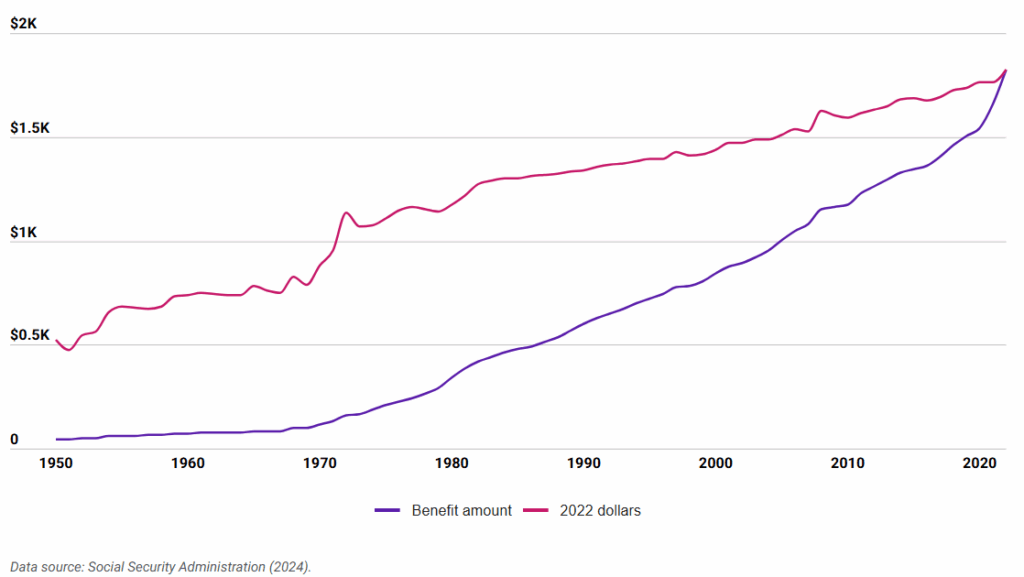What if you had invested every Social Security check instead of spending it? Over the last 10 years, that decision could have added hundreds of thousands to your retirement nest egg. Let’s break down how.

Social Security Check for 10 Years
| Strategy | Avg Annual Return | 10-Year Ending Value | Source |
|---|---|---|---|
| S&P 500 (SPY ETF) | ~8% | ~$348,000 | U.S. SEC |
| U.S. Treasury Bonds | ~4% | ~$279,000 | U.S. Treasury |
| Total Contributions | N/A | $228,360 | SSA |
Investing every Social Security check may not be practical for everyone—but the math makes a strong case. Over a decade, you could have nearly $300,000 to $350,000, depending on your risk tolerance and investment strategy.
It’s a powerful reminder: consistent investing—even of government benefits—can yield serious rewards.
How Much Is the Average Check?
As of mid-2025, the average retired worker receives $1,903 per month in Social Security benefits. That amounts to about $22,836 annually. If you consistently received and invested this money each month over the past decade—June 2015 to June 2025—you would have contributed $228,360 in total.
Now let’s look at how that money could have grown.
What If You Invested in the S&P 500?
The S&P 500, often used as a proxy for the U.S. stock market, has historically returned about 10% per year. Adjusting for volatility, let’s assume a moderate 8% annualized return. That’s about 0.67% per month.
Using the future value of a series formula, your $1,903 monthly investments over 120 months (10 years) would have grown to approximately $348,000.
I’ve personally watched clients build similar portfolios over time, and while the market has its ups and downs, consistent investing often pays off in the long haul.

Prefer Something Safer?
Not everyone wants to ride the stock market rollercoaster. If you’d opted for U.S. Treasury Bonds—which are considered ultra-safe and recently yielded around 4% annually—your investment would still have grown to about $279,000.
Sure, that’s $69K less than stocks. But for risk-averse retirees, the peace of mind can be worth the trade-off.
Why Timing and Consistency Matter
This isn’t just a math exercise—it’s a lesson in financial discipline. By sticking to a consistent investment plan and reinvesting dividends over time, compound interest does the heavy lifting.
Here’s the basic math:
- Stocks (SPY ETF): ~$348K after 10 years
- Treasuries (4% average): ~$279K
- Just Saving It: $228,360 (no growth)
And yes, these numbers assume no early withdrawals, no taxes, and that every check went straight into an investment account. Not exactly realistic for most retirees—but eye-opening all the same.
What About Delaying Benefits?
Some folks wait to claim Social Security until age 70 to increase their monthly payout. That’s smart in many cases. But if you’re healthy, have other income, and can afford to invest those checks instead of spending them, the compounding advantage may outweigh waiting.
A 2023 paper from the National Bureau of Economic Research even noted that “early but invested” scenarios often rival or surpass the value of delayed claims.
A Realistic Middle Ground
You don’t need to invest every check to see results. Even putting away a portion—say $500 a month—could result in nearly $90,000 in 10 years with a modest 8% return.
That’s a used RV. A grandchild’s college fund. A safety net.
What the Experts Say
“If you treat Social Security like a supplement and not a lifeline, your money can work for you in a big way,” says Ann Garcia, CFP and author of The College Financial Lady blog. And she’s right. Even modest investing can make a meaningful impact.






